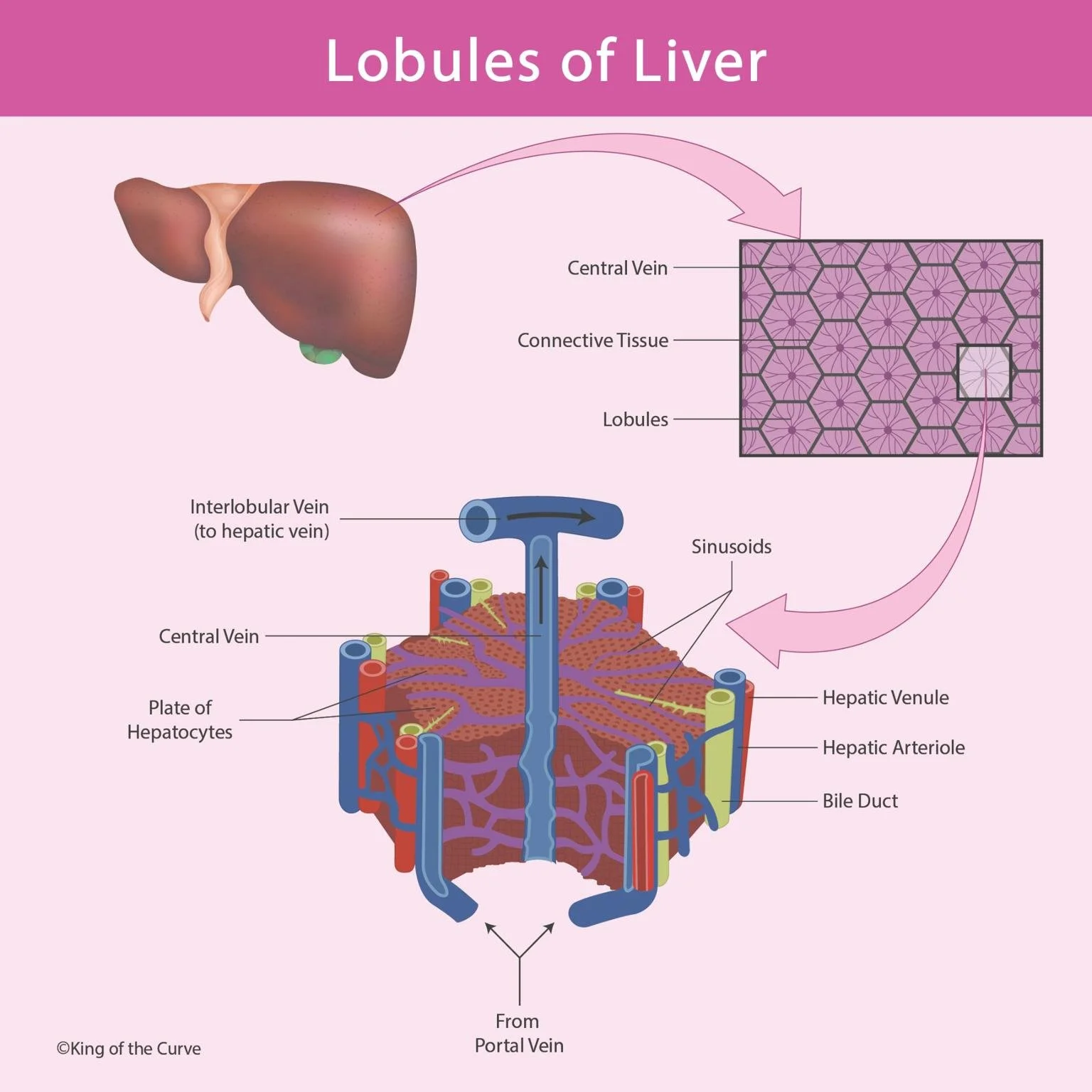🧬 Lobules of Liver: Structure, Function, and Blood Flow Explained
The liver is one of the most versatile organs in the human body — functioning as a detoxifier, nutrient processor, and energy reservoir. The foundation of its efficiency lies in its microscopic structure: the hepatic lobule. Each lobule operates like a biological factory, ensuring that every molecule of blood passing through is refined, detoxified, and enriched before returning to circulation.
🧠 Structure of the Liver Lobule
Each liver lobule consists of plates of hepatocytes arranged around a central vein, forming the liver’s basic structural unit. Between these plates lie sinusoids, channels that allow blood from the portal vein and hepatic artery to mix and flow toward the central vein. At the corners of each lobule lies a portal triad, made up of a branch of the hepatic artery, branch of the portal vein, and a bile duct.
This intricate network supports bidirectional flow: while blood moves inward toward the central vein, bile moves outward toward the bile ducts. This opposite movement ensures simultaneous filtration, detoxification, and bile secretion, all within the same microenvironment.
⚙️ Flow Directions within the Lobule
| Flow Type | Direction | Key Structures Involved | Purpose |
|---|---|---|---|
| Blood Flow | From the portal triads → central vein | Portal vein & hepatic artery → sinusoids → central vein | Brings oxygen and nutrients to hepatocytes |
| Bile Flow | From hepatocytes → bile ducts | Hepatocytes → bile canaliculi → bile duct | Removes waste & aids fat digestion |
| Venous Drainage | From central vein → hepatic vein → inferior vena cava | Central vein → interlobular vein → hepatic vein | Returns filtered blood to systemic circulation |
💡 KOTC Tip: Always remember that blood and bile flow in opposite directions — a concept frequently tested on the MCAT, USMLE, and NCLEX to evaluate understanding of hepatic physiology.
🩸 Functional Significance
The liver lobule serves as a hub for several essential physiological functions:
Detoxification — Hepatocytes metabolize drugs, alcohol, and toxins.
Nutrient Metabolism — Glucose is stored as glycogen, and fats and proteins are synthesized.
Filtration — Kupffer cells capture and destroy bacteria and worn-out blood cells.
Bile Production — Facilitates fat digestion and absorption in the intestines.
When the delicate architecture of the lobule is disrupted — as seen in conditions like cirrhosis or steatohepatitis — these processes begin to fail, leading to systemic complications such as jaundice, portal hypertension, and hepatic encephalopathy.
🧩 Clinical Relevance: Linking Structure to Disease
Damage to hepatocytes or fibrosis around the central vein can alter blood flow through the sinusoids, increasing vascular resistance. This leads to portal hypertension, where blood struggles to pass through the liver, causing backup in the portal system. Similarly, damage to bile ducts can result in cholestasis, impairing bile secretion and fat digestion. Understanding how these microstructures contribute to disease is critical for diagnosing liver disorders and designing effective treatments.
🔬 Beyond Anatomy: Integrating Physiology and Pathology
The liver lobule exemplifies how microscopic organization defines organ-level performance. The bidirectional flow system — blood inward, bile outward — highlights how structure and function intertwine seamlessly. This dynamic coordination not only enables nutrient processing but also underpins the liver’s remarkable regenerative capacity. When damage occurs, surviving hepatocytes can proliferate to restore lobular integrity, a process central to liver healing and recovery.
By mastering the details of lobular microanatomy, students gain a deeper appreciation for the interconnectedness of cell biology, histology, and clinical medicine — helping them recognize how molecular dysfunction can manifest as systemic disease.
🚀 Call to Action: Learn Smarter with King of the Curve
Learning liver anatomy doesn’t have to be overwhelming. King of the Curve transforms complex medical concepts into clear, memorable visuals that stick. Whether you’re reviewing hepatic histology for your next exam or brushing up for the boards, our interactive learning platform makes high-yield topics simple and engaging.
Frequently Asked Questions (FAQs)
-
Aim for 4-6 focused hours, ensuring you incorporate breaks to avoid burnout.
-
Practice mindfulness techniques, take practice exams under realistic conditions, and maintain a balanced lifestyle.
-
Set short-term goals, seek support from mentors, and reward yourself for small achievements.
-
Regular exercise improves focus, reduces stress, and enhances overall mental clarity.
-
KOTC offers personalized learning tools, gamification features, and adaptive question banks to help students stay on track without burnout.


